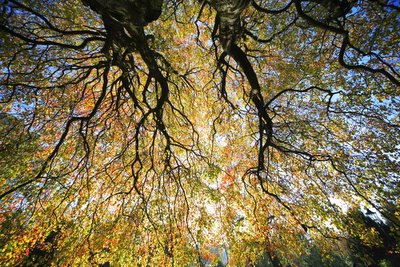Qualities of Architectural Space
 This photo (click on the image to see a larger pic) was taken on Saturday in The Museum Gardens, York, UK. I found myself being drawn to the centre of the tree, beneath its canopy and wondered what were the constituents of such magnetic qualities?
This photo (click on the image to see a larger pic) was taken on Saturday in The Museum Gardens, York, UK. I found myself being drawn to the centre of the tree, beneath its canopy and wondered what were the constituents of such magnetic qualities?
The answer is that the tree (especially a tree such as this) has the qualities of space and enclosure that we create in our homes and our workplaces. Here is a setof 'keywords' which come to mind when looking at the image:-
'enclosure, warmth, light, translucency, ambience, colour, safety, security, cover, texture, volume, scale, tone, organic, symmetry, asymmetry, growth, arterial, aspirational, hue, saturation, luminescence, permeability, porous, boundary, border, vista, etc'
Francis D.K. Ching in his remarkable book 'Architecture - Form, Space, and Order' (Wiley, New York) states that the key properties of enclosure are : shape, surface, edges, dimensions, configuration, openings. He goes on to say that the key qualities of space are: form, color, texture, pattern, sound, proportion, scale, definition, degree of enclosure, light, view.
Many times I am in an a space which is comfortable, staid, and secure but doesn't have the x factor which this image portrays. I think that what I am trying to say is that it takes much more than a design and a little research to make a great building or a fabulous space. The tree has made a perfect synergy between form and function and it is somewhere between its form and function that its energy resides.
The tree is of the hill that it resides upon, and the keywords noted above go some way into providing a sort of embryonic swatch to articulating a space which has the x factor.
Ching also states that 'The qualities of an architectural space.... are much richer than what.... diagrams are able to portray. The spatial qualities of form, proportion, scale, texture, light, and sound ultimately depend on the properties of the enclosure of a space. Our perception of these qualities is often a response to the combined effects of the properties encountered and is conditioned by culture, prior experiences, and personal interest or inclination'.
When I experience a wonderful space and I am energised by it, I try and process that feeling of awe or inspiration into a swatch of keywords which at least are pointers to why the space is successful and at most, forms the inspiration which ties into the warp and weft of my own photographic work.


5 comments:
Would you say this is akin to the organic architecture musings of Frank Lloyd Wright. He ultimately suggests though that the architect has to "meld" the concepts of good architecture with the needs and considerations of the client.
He also was much for walls or unnatural materials.
There is a new genre in Western home fashion which somewhat challenges that legacy. I saw a show on "New Country Style" rather odd and bold it was....
sir
sorry that should be he, Mr. Wright
Was "not" much for walls and unnatural materials. As well his early structures tried to meld the architecture into the landscapes and neighbourhoods I guess he encountered.
Or are we re-capitulating the Art Nouveau or even the Gaudiesque? Taking the organic element aside I find it always a useful tool to try and encapsulate what you feel about a space into a swatch of words, lines and images.
Ah it was German Poet Goethe
who on his death lay and said...
Goethe, German Poet
"Light, More light!"
Gaudiesque Link = http://mirrormaze.blogspot.com/2005_01_01_mirrormaze_archive.html
Rather weird which used to mean "magical"
though somewhat "ghostly" as well...
Reminisent of the period in European history where devoid of hope and money
the built huge spires, ghouls, and such
Are you suggesting that is what we may
be doing with the internet....
I would say thats what happens perhaps when builders lack a plan...
they build up to the light perhaps forgetting that humans are creatures or mammals of "warmth"....
warmth seems more "heartful" than
light which like "photonics" is somewhat more cerebral....
do you any reference to "warm architecture"
hmmmmmmm "warm architecture" what a concept....
sir swan
References to warm architecture
alamy search for 'warm architecture' brings up over 7000 images try it here
www.alamy.com and type 'warm architecture' into search
Post a Comment